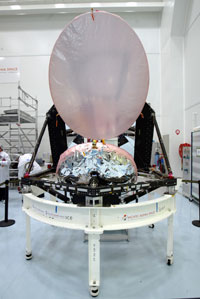The Big Bang Theory is the leading explanation about how the universe began. At its simplest, it says the universe as we know it started with a small singularity, then inflated over the next 13.8 billion years to the cosmos that we know today.
Because current instruments don't allow astronomers to peer back at the universe's birth, much of what we understand about the Big Bang Theory comes from mathematical formulas and models. Astronomers can, however, see the "echo" of the expansion through a phenomenon known as the cosmic microwave background.
While the majority of the astronomical community accepts the theory, there are some theorists who have alternative explanations besides the Big Bang — such as "eternal inflation or an oscillating universe".
Since scientists first proposed the big bang theory, many people have questioned and criticized the model. Here's a rundown on some of the most common criticisms of the big bang theory:
- It violates the first law of thermodynamics, which says you can't create or destroy matter or energy. Critics claim that the big bang theory suggests the universe began out of nothing. Proponents of the big bang theory say that such criticism is unwarranted for two reasons. The first is that the big bang doesn't address the creation of the universe, but rather the evolution of it. The other reason is that since the laws of science break down as you approach the creation of the universe, there's no reason to believe the first law of thermodynamics would apply.
- Some critics say that the formation of stars and galaxies violates the law of entropy, which suggests systems of change become less organized over time. But if you view the early universe as completely homogeneous and isotropic, then the current universe shows signs of obeying the law of entropy.
- Some astrophysicists and cosmologists argue that scientists have misinterpreted evidence like the redshift of celestial bodies and the cosmic microwave background radiation. Some cite the absence of exotic cosmic bodies that should have been the product of the big bang according to the theory.
- The early inflationary period of the big bang appears to violate the rule that nothing can travel faster than the speed of light. Proponents have a few different responses to this criticism. One is that at the start of the big bang, the theory of relativity didn't apply. As a result, there was no issue with traveling faster than the speed of light. Another related response is that space itself can expand faster than the speed of light, as space falls outside the domain of the theory of gravity.
The gravitational waves controversy of 2014
While astronomers could see the universe's beginnings, they've also been seeking out proof of its rapid inflation. Theory says that in the first second after the universe was born, our cosmos ballooned faster than the speed of light. That, by the way, does not violate Albert Einstein's speed limit since he said that light is the maximum anything can travel within the universe. That did not apply to the inflation of the universe itself.
In 2014, astronomers said they had found evidence in the CMB concerning "B-modes," a sort of polarization generated as the universe got bigger and created gravitational waves. The team spotted evidence of this using an Antarctic telescope called "Background Imaging of Cosmic Extragalactic Polarization", or BICEP2.
"We're very confident that the signal that we're seeing is real, and it's on the sky," lead researcher John Kovac, of the Harvard-Smithsonian Center for Astrophysics, told Space.com in March 2014.
There are several alternative models that attempt to explain the development of the universe, though none of them have as wide an acceptance as the big bang theory:- The steady-state model of the universe suggests the universe always had and will always have the same density. The theory reconciles the apparent evidence that the universe is expanding by suggesting that the universe generates matter at a rate proportionate to the universe's rate of expansion.
- The Ekpyrotic model suggests our universe is the result of a collision of two three-dimensional worlds on a hidden fourth dimension. It doesn't conflict with the big bang theory completely, as after a certain amount of time it aligns with the events described in the big bang theory.
- The big bounce theory suggests our universe is one of a series of universes that first expand, then contract again. The cycle repeats after several billion years.
- Plasma cosmology attempts to describe the universe in terms of the electrodynamic properties of the universe. Plasma is an ionized gas, which means it's a gas with free roaming electrons that can conduct electricity.
There are several other models as well. Could one of these theories (or other ones we haven't even thought of) one day replace the big bang theory as the accepted model of the universe? It's quite possible. As time passes and our capability to study the universe increases, we'll be able to make more accurate models of how the universe developed.
Hope you enjoyed this post. Please leave a comment.
Hope you enjoyed this post. Please leave a comment.


No comments:
Post a Comment